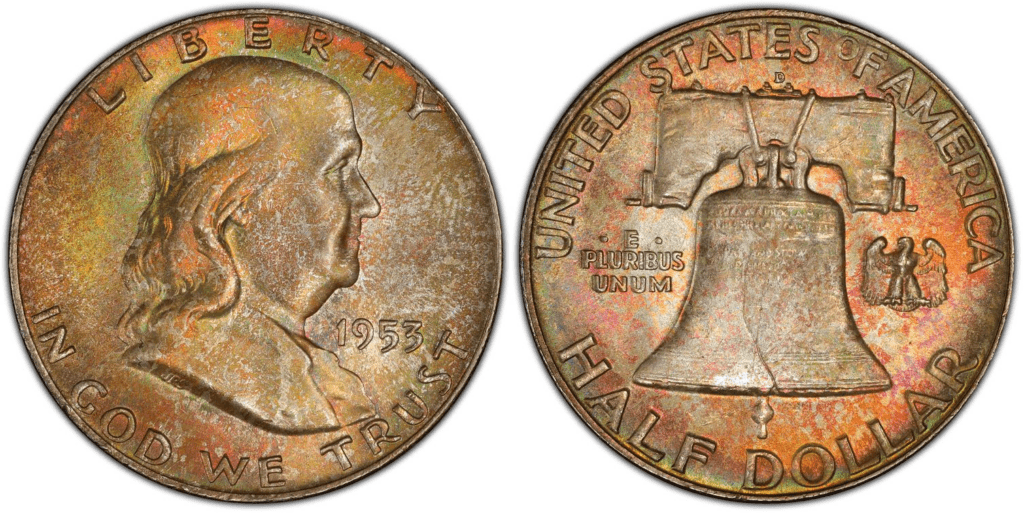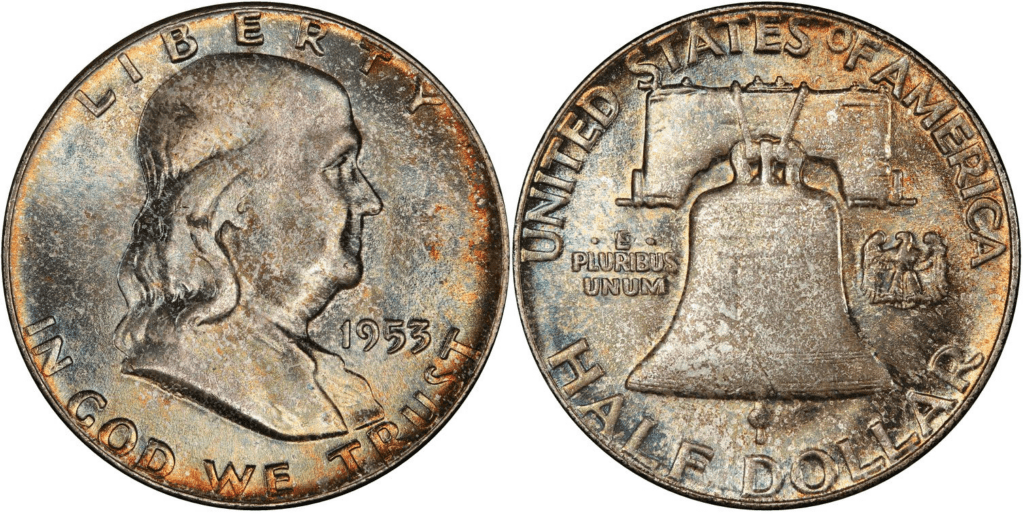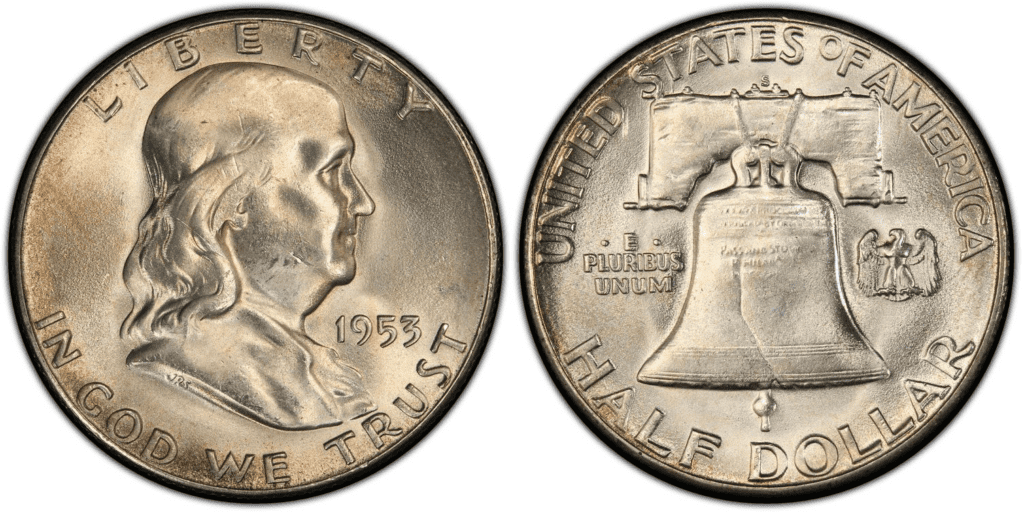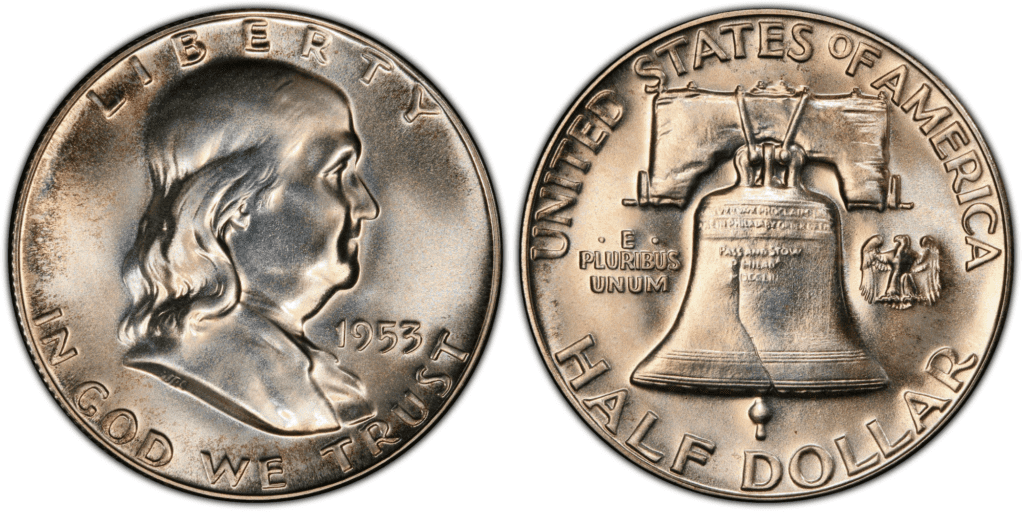What Is the 1953 Franklin Half Dollar Made Of?
The 1953 Franklin Half Dollar is a well-known coin in the U.S.A. with a face value of $0.50 and is made of 90% silver and 10% copper. All the coins minted from 1948 to 1963 have the same composition.
The half-dollar coin was struck at the mints in Denver, Philadelphia, and San Francisco with a reeded edge. It was struck regularly until 1963. Its specifications also include the following:
- Diameter – 31.61 mm
- Mass – 12.50 g
- Thickness – 1.8 mm
The fifty-cent silver coin was engraved with Benjamin Franklin’s portrait. The then-mint director Nellie Tayloe Ross was inspired by Franklin’s “A penny saved is twopence dear.” Hence, she instructed the chief engraver John Sinnock to design the coin. However, Sinnock died before the design was completed, so his successor, Gilroy Roberts, finished the design.

The coin’s obverse features the portrait profile of the Founding Father Benjamin Franklin with flowing hair cut off his shoulder. As you can see in the image above, the following inscriptions were also featured:
- LIBERTY
- IN GOD WE TRUST
- 1953
The reverse side, meantime, features the Liberty Bell with the following inscriptions:
- UNITED STATES OF AMERICA
- HALF DOLLAR
- E PLURIBUS UNUM
- Small eagle – placed at the right side of the bell
Though the coin was released in April 1948, it has experienced controversies. The Mint received accusations that the initials “J.R.S.” of Sinnock and the hair cutoff at Franklin’s shoulder were a tribute to Soviet dictator Joseph Stalin.
Apart from that, the Commission of Fine Arts disliked the small eagle design. They also believed that the cracked Liberty Bell design would be exposed to jokes and ridicule. Despite this, the 1953 half-dollar coin was still popular with many collectors for having featured Benjamin Franklin on it being one of the most famous Americans in history.
Out of the 482 million Franklin fifty-cent coins struck for circulation and proof, about 28 million coins were made in 1953 of the half dollar.
1953 Franklin Half Dollar Varieties
The 1953 Franklin fifty-cent coins were produced in at least four varieties. These are 1953-D, 1953-P, 1953-S, and 1953 Proof. Apart from these varieties, some half-dollar coins were also made with minting errors.
A complete set of Franklin halves consist of 35 varying business strikes and 14 other proofs. Most collectors are basing their collections on date and Mint. Those who can afford it are after finer minted coins like MS-65 and above. Franklin Half Dollar with deep cameo contrast appears attractive for some collectors.
Let’s take a look at the description of these varieties and coin errors below:
1953 D Franklin Half Dollar
Year of minting: 1953
Mint Mark: D – above yoke of the bell and below letter E in STATES
Place of minting: Denver
Quantity produced: 20,900,400
Face Value: $0.50 (fifty cents)
Price: $0.50 to $30 (or more)
Mass: 2.50 grams
Edge: Reeded
Designer: John R. Sinnock/John Frederick Lewis
Composition: 90% Silver, 10% Copper
Diameter: 30 mm
Thickness: 1.8 mm

photo source: PCGS
They produced more than 20 million of the 1953 Franklin Half Dollar value coin at the Denver mint. Due to its rarity and condition, the 1953 fifty-cent coin was auctioned at a record high of $17,250 for its MS67 grade in 2005.
1953 P Franklin Half Dollar
Year of minting: 1953
Mint Mark: Coins were struck without a mint mark
Place of minting: Philadelphia
Quantity produced: 2,668,120
Face Value: $0.50 (fifty cents)
Price: $0.50 to $53 (or more)
Mass: 2.50 grams
Edge: Reeded
Designer: John R. Sinnock/John Frederick Lewis
Composition: 90% Silver, 10% Copper
Diameter: 30 mm
Thickness: 1.8 mm

photo source: PCGS
The 1953-P Franklin Half Dollar is known for its lowest mintage. It has the second-lowest mintage in the series. Though it is easily obtainable, you would find that the Uncirculated grade for the 1953 fifty-cent becomes scarcer than the other coins in the series. No coins are finer than the MS66 grade of this coin, with only about 150 samples existing.
1953 S Franklin Dollar
Year of minting: 1953
Mint Mark:
Place of minting: San Francisco
Quantity produced: 4,148,000
Face Value: $0.50 (fifty cents)
Price: $0.50 to $60 (or more)
Mass: 2.50 grams
Edge: Reeded
Designer: John R. Sinnock/John Frederick Lewis
Composition: 90% Silver, 10% Copper
Diameter: 30 mm
Thickness: 1.8 mm

photo source: PCGS
The 1953 Franklin fifty-cent minted in San Francisco with Full Bell Line characteristics is the key coin to the entire circulation strike Franklin half-dollar series. Out of the more than 4 million 1953-S Franklin Half Dollar minted coins, less than 50 examples are known as Full Bell Lines. Most MS65 conditions and higher show Full Bell Lines characteristics.
1953 P Franklin Half Dollar (Proof)
Year of minting: 1953
Mint Mark:
Place of minting: Philadelphia
Quantity produced: 128,800
Face Value: $0.50 (fifty cents)
Price: $0.50 to $432 (or more)
Mass: 2.50 grams
Edge: Reeded
Designer: John R. Sinnock/John Frederick Lewis
Composition: 90% Silver, 10% Copper
Diameter: 30 mm
Thickness: 1.8 mm

photo source: PCGS
There may be less than 129 million minted for the 1953-P Franklin fifty-cent Proof. However, its auction in 2019 got a record high of $9,000 for its PR69 grade.
1953 Franklin Half Dollar Errors
While over 28 million of 1953 Franklin fifty cents were produced, mint-made errors happened during the minting process. Thousands of minting error coins are usually a result of the deteriorating minting equipment. More often than not, malfunctions and accidents occur during minting. Human errors also contributed to the number of the 1953 Franklin Half Dollar error coins produced.
The labels for each category of errors usually describe the cause of the error, such as:
- Die crack
- Rotated die
- Clipped planchet
- Bank planchet
- Weak strike
- Off-center strike
- Broadstrike
- Lamination error
- Cladding flaw
- Missing design elements
- Mule
Most of these errors are unintentional, but even so, due to the uniqueness of these error coins, many collectors find them distinct and unique. Its rarity also makes it valuable to many numismatists.
How Much Is 1953 Franklin Half Dollar Worth Today?
The 1953 Franklin Half Dollar has a face value of $0.50. As it is made of 90 percent silver and 10 percent copper, its melt value is based on the latest price of the market’s metals and the specifications.
At the current price, the 1948-1963 silver Franklin half a dollar’s approximate melting value is $8.1269. As this is just an approximation, the melting value will vary according to the prices of the silver and copper metals in the market.
You can find the different values of the 1953 Franklin fifty-cent in the chart below:
| Coin | Condition | Grade | Mintage | Value |
| 1953 D Franklin half dollar | Circulated/Mint | Not graded | 20,900,400 | $0.50 to $30 |
| 1953 D Franklin half dollar | Uncirculated/Mint | MS-65 | 20,900,400 | $61 to $264 |
| 1953 D Franklin half dollar | Uncirculated/Mint | MS-66 | 20,900,400 | $264 to $3,105 |
| 1953 D Franklin half dollar | Uncirculated/Mint | MS-67 | 20,900,400 | $17,250 |
| 1953 P Franklin half dollar | Circulated/Mint | Not graded | 2,668,120 | $0.50 to $53.00 |
| 1953 P Franklin half dollar | Uncirculated/Mint | MS-65 | 2,668,120 | $159 to $360 |
| 1953 P Franklin half dollar | Uncirculated/Mint | MS-66 | 2,668,120 | $25 to $108 |
| 1953 P Franklin half dollar | Uncirculated/Mint | MS-67 | 2,668,120 | $2,160 to $3,360 |
| 1953 S Franklin half dollar | Circulated/proof | Not graded | 3,028,244 | $0.50 to $60.00
|
| 1953 S Franklin half dollar | Uncirculated/proof | MS-65 | 3,028,244 | $65 to $144 |
| 1953 S Franklin half dollar | Uncirculated/proof | MS-66 | 3,028,244 | $124 to $376 |
| 1953 S Franklin half dollar | Uncirculated/proof | MS-67 | 3,028,244 | $810 to $3,819 |
| 1953 P Franklin half dollar (Proof) | Uncirculated/proof | Not graded | 128,800 | $0.50 to $432.00
|
| 1953 P Franklin half dollar (Proof) | Uncirculated/proof | PR-67 | 128,800 | $312 to $440 |
| 1953 P Franklin half dollar (Proof) | Uncirculated/proof | PR-68 | 128,800 | $720 to $1,560 |
| 1953 P Franklin half dollar (Proof) | Uncirculated/proof | PR-69 | 128,800 | $3,565 to $9,000 |
As you can see, even if the face value or melt value of the 1953 half dollar isn’t that big, other 1953 50-cent coins are astronomically more valuable.
Take a look at the auction records of 1953 half-dollar coins:
- 1953-D 50C, FBL with MS67 grade sold for $30,550
- 1953 50C, FBL with MS66+FBL grade sold for $11,500
- 1953-S 50C with MS66 grade sold for $69,000
- 1953 50C DCAM (Proof) with PR68 grade sold for $63,250
It’s hard to believe that a 50-cent coin would be worth thousands of dollars. Yet, these auction records show you the value of a 50-cent coin.
How Does The Grading System Work?
The Sheldon Scale is used by numismatists to provide a numerical value to coins. The Sheldon Scale goes from poor (P-1) to perfect mint state (P-1) (MS-70). Coins were originally evaluated using words to reflect their condition (Good, Fair, Excellent, Etc.). Unfortunately, coin collectors and dealers had different ideas about what each of these terms represent.
Professional numismatists joined together in the 1970s and established CoinGrading standards. These numismatists now assign grades at key places on the seventy-point scale, using the most regularly utilized numeric points in conjunction with the original adjective grade. The following are the most common coin grades:
-
-
- (P-1) Poor – Indistinguishable and probably damaged; if used, must have a date and mintmark; otherwise, rather battered.
- (FR-2) Fair – Nearly smooth, but without the damage that a coin graded Poor often possesses. The coin must have enough detail to be identified.
- (G-4) Fair – Inscriptions have merged into the rims in some areas, and important elements have been mostly erased.
- (VG-8) Very Good- A little weathered, but all of the primary design elements are visible, albeit faintly. There is little if any, central detail left.
- (F-12) Good – The item is very worn, yet the wear is even, and the overall design details stand out clearly. Rims are almost completely isolated from the field.
- (VF-20) Very Fine – Moderately weathered, with some finer features still visible. The motto or all letters of LIBERTY are readable. Both sides of the coin have entire rims that are separated from the field.
- (EF-40) Extremely Fine – Gently used; all gadgets are visible, and the most important ones are bold. The finer details are bold and clear, however, light wear may be seen.
- (AU-50) Uncirculated – Slight evidence of wear on the coin’s design’s high points; may have contact marks; eye appeal should be adequate.
- (AU-58) Uncirculated Choice – Slight traces of wear, no severe contact marks, almost full mint shine, and great eye appeal.
- (MS-60) Mint State Basal – Strictly uncirculated; no indication of wear on the coin’s highest points, but an unsightly coin with reduced luster, visible contact marks, hairlines, and other flaws.
- (MS-63) Mint State Acceptable – Uncirculated, but with contact scratches and nicks, little reduced shine, but otherwise appealing appearance. The strike is weak to average.
- (MS-65) Mint State Choice – Uncirculated with great mint shine, very little contact blemishes, and exceptional eye appeal. The strike is unusually severe.
- (MS-68) Mint State Premium Quality – Uncirculated with superb luster, no obvious contact marks to the naked eye, and exceptional eye appeal. The strike is quick and appealing.
- (MS-69) Almost Perfect Mint State – Uncirculated with perfect brilliance, a sharp and appealing strike, and extremely good eye appeal. A near-perfect coin with minor imperfections in the planchet, strike, and contact markings (seen only under 8x magnification).
- (MS-70) Mint State Perfect – Under 8x magnification, there are no tiny imperfections discernible; the strike is crisp, and the coin is perfectly centered on a beautiful planchet. Rarely seen on a coin, this coin is bright and whole, with original luster and exceptional eye appeal.
-
Where To Buy Or Sell 1953 Franklin Half Dollar?
Based on the NGC’s pricing and value, the 1953 Franklin Half Dollar in circulated condition can be bought between $9.50 and $12. However, on the open market, the 1953 Franklin fifty-cent coin in pristine, uncirculated condition can be sold for as much as $4600.
When you check out eBay or Amazon, you can find good quality 1953 Franklin Half Dollar coins. As it has the second lowest mintage strike, you can explore what’s on sale and find the rarities of your collection. It comes in different conditions and prices.
If you’re into online sales, it is best to list your Franklin fifty-cent on these sites too. A lot of potentially good buyers are usually on the lookout online.
Aside from that, you can also find some coin shops that offer you a reasonable price for your fifty-cent coin (either you buy or sell). Some pawn shops, antique stores, and auction houses are your go-to places.
Also, consulting the coin experts from PCGS or NGC can help you find and sell your coins.
F.A.Q.s
Is a 1953 half dollar made of silver?
Yes, it is. The 1953 Franklin fifty-cent is composed of 90% silver. Copper (10%) is mixed with silver to create the coin.
Where is the mint mark on a 1953 half dollar?
The Mint marks “D” and “S” for the 1953 Franklin Half Dollar can be seen on the coin’s reverse side, above the Liberty Bell yoke.
Is there anything special about a 1953 penny?
The 1953 Franklin Half Dollar is a fifty-cent piece, which makes it different from many other coins available, like those with face values of $1, $5, or many more. Apart from that, the coin is also valued based on its silver content.
In addition to that, many collectors find it special because of its advancing age. Knowing that this coin ceased being minted more than half a century ago, many find the fifty-cent pieces with great historical value.
Though not considered rare, being produced in limited mintages in the early years, many collectors would desire to get some of the 1953 Franklin Half Dollar original editions.




